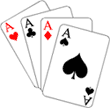|
 Red Dog is a variation of acey-duecey or in-between.
All cards are ranked as in poker, the suit is irrelevant, and aces are always
high. First the player places a wager. Then the dealer places two cards on the
table face up. If the two cards are consecutive then the hand is a push. If the
two cards are equal a third card is dealt, a matching third card pays 11:1,
otherwise the hand is a push.
If the two cards are neither consecutive nor equal the dealer announces the
spread, or the number of card values in between the cards. For example a 5 and
10 would have a spread of 4. The player is then given a chance to increase the
wager up to the amount of the original wager. Then a third card is dealt, if it
is in between the first two cards the player wins according to the following
payout table, if it matches or is outside the first two cards the player loses.
Strategy
The following table shows the net return per unit bet on various
spreads, assuming a six deck game. As you can see only spreads of seven or more
are favorable. Thus the player should only raise on spreads of 7 or more, which
is true regardless of the number of decks used.
|
Expected Gain by Raising
|
|
Spread
|
Pays
|
Probability
of winning |
Player's
edge |
|
1
|
5
|
0.077419
|
-0.535484
|
|
2
|
4
|
0.154839
|
-0.225806
|
|
3
|
2
|
0.232258
|
-0.303226
|
|
4
|
1
|
0.309677
|
-0.380645
|
|
5
|
1
|
0.387097
|
-0.225806
|
|
6
|
1
|
0.464516
|
-0.070968
|
|
7
|
1
|
0.541935
|
0.083871
|
|
8
|
1
|
0.619355
|
0.238710
|
|
9
|
1
|
0.696774
|
0.393548
|
|
10
|
1
|
0.774194
|
0.548387
|
|
11
|
1
|
0.851613
|
0.703226
|
|